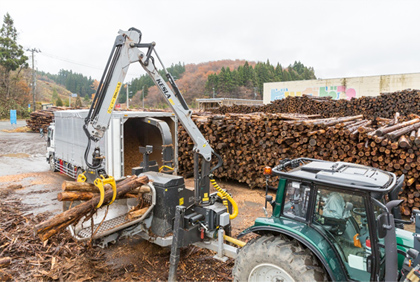-


What changes have taken place in forestry in Akita Prefecture since you became involved?
Until my junior high school days, trees were cut with a saw and lumber was conveyed with horse sleighs. My father loved anything new and bought a chain saw when I entered junior high. In those days, it made tremendous vibrations. In 1969, the prefectural governor took the initiative in afforesting 10,000 hectares of land per year. That gave momentum to the planting of Japanese cedar trees. Today, Akita Prefecture is ranked first in Japan in terms of the area of planted forest. Cedar trees planted at the time now need to be thinned. Akita cedar lumber was originally utilized as a building material. Today, it is rarely used as a material for general residential buildings, given the dominance of imported lumber and the emergence of new building materials. As a result, even though lumber is produced, it is hardly marketable.
-
What changes happened after the biomass power plant came into being?
It created a new job of processing into chips as biomass fuel. Foresters can earn money from lumber from thinning and other lumber that was once unprofitable. Stable earnings allowed us to hire five additional staff members. Nowadays, young employees have children to raise.
What are your thoughts about the future of forestry?
The Ise Grand Shrine in Mie Prefecture and other shrines grow trees for reconstructing shrine buildings once every 20 years. This tradition helps maintain carpentry techniques. For as long as there are temple and shrine carpenters, their techniques will survive. The development of forestry in Akita Prefecture requires processing techniques for selling lumber at high prices for a long time. For this purpose, there must be skilled personnel possessing the techniques to develop successors. We will work to train forestry personnel and to develop local forestry to add value and to ensure that young forestry workers can continue to make their living in Akita Prefecture.
* Affiliates and titles etc. of the interviewees are current as of the time of the interview or publication.


